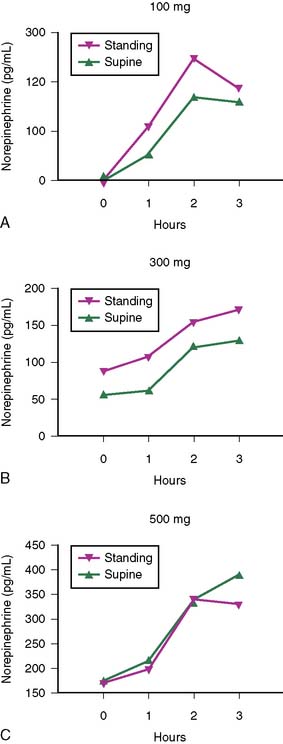Figure 61-1 Beat-to-beat blood pressure responses to Valsalva maneuver are shown for both an age- and gender-matched control subject (top) and our patient with DBH deficiency (bottom). The control study is normal with preserved late phase II and phase IV responses, as indicated by the vertical bars (top). Our patient with dopamine-ß-hydroxylase deficiency has an exaggerated fall in phase II, with a blunted late phase II and absent phase IV responses (bottom). The horizontal black bar indicates the duration of Valsalva maneuver.
As a result, treatment with oral L-DOPS was initiated. L-DOPS was associated with resolution of orthostatic symptoms. On a dose of 300 mg bid, the patient regained orthostatic normotension. A dose-response inpatient study confirmed the dose-dependent increase in plasma norepinephrine with administration of L-DOPS (Fig. 61-2).

Figure 61-2 Catecholamine response to treatment with L-DOPS administered orally. Head-up tilt was performed at baseline and at 1-, 2-, and 3-hour intervals post L-DOPS administration (A, 100 mg; B, 300 mg: C, 500 mg). Treatment with L-DOPS resulted in significant increase in both supine and standing norepinephrine levels. The norepinephrine metabolite dihydroxyphenylglycol had a similar response to L-DOPS treatment (data not shown).
CONCLUSIONS
DBH deficiency is a rare genetic disorder leading to severe sympathetic dysfunction with prominent OH.2 Early descriptions of the disorder included absent plasma norepinephrine/epinephrine levels with corresponding elevated plasma dopamine levels.3,4 The DBH enzyme has also been reported to be absent in central autonomic neurons, specifically the rostral ventrolateral medulla, which may further contribute to the autonomic dysfunction seen in these patients.5 The DBH gene is located on chromosome 9q34. There are multiple missense or noncoding mutations described that led to the absence of detectable DBH enzyme levels and the typical plasma catecholamine pattern described.2,6,7
DBH deficiency can manifest in the perinatal period with episodic hypothermia, hypoglycemia, and hypotension.8 Complicated perinatal course, delayed eye opening, and vomiting have also been reported as common in neonates.2 However affected individuals can do well into late adolescence or early adulthood until progressive OH profoundly impairs their daily lives.8 Consequently the majority of cases are diagnosed in young or middle-aged adults. OH may be so severe that seizures can occur.8 Our patient’s clinical course was typical with moderate orthostasis in childhood and development of frank OH in late adolescence.
The initial descriptions of the disorder led multiple investigators to undertake treatments directed toward replacing the enzymatic activity lost in DBH deficiency. Several reports showed marked improvement in OH with treatment with D,L-threo-3,4-dihydroxyphenylserine, a racemic mixture of both L-DOPS and its stereoisomer.9 L-DOPS has been reported to be as effective to the point where one patient with severe OH was able to complete a marathon after treatment.10 The same profound improvement was seen in our patient.
Stay updated, free articles. Join our Telegram channel

Full access? Get Clinical Tree








